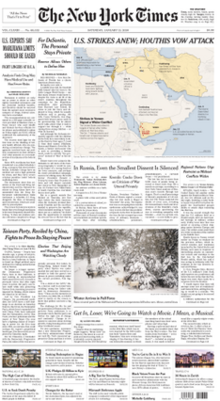News Articles Things To Know Before You Get This
News Articles Things To Know Before You Get This
Blog Article
The Best Guide To News Articles
Table of ContentsThe Main Principles Of News Articles Getting The News Articles To Work10 Simple Techniques For News Articles4 Easy Facts About News Articles ShownEverything about News Articles
Excellent expertise of different topics offers trainees an one-upmanship over their peers. Despite the fact that digital and social media sites are easily obtainable, we need to not forget how important it is to read the newspapers. Moms and dads must try and instill the behavior of checking out a paper as a daily regimen to proceed the tradition of the adored print medium.News stories additionally consist of at least one of the adhering to important features family member to the intended audience: closeness, importance, timeliness, human interest, quirk, or consequence.
Within these limitations, information tales additionally aim to be extensive. Amongst the bigger and more revered newspapers, fairness and equilibrium is a major variable in providing information.
Papers with a worldwide audience, for instance, often tend to utilize a much more official style of composing. The certain selections made by a news outlet's editor or content board are typically gathered in a style overview; usual design overviews include the and the US News Style Book. The major objectives of information writing can be summed up by the ABCs of journalism: precision, brevity, and clearness.
The Basic Principles Of News Articles
As a regulation, journalists will not use a long word when a brief one will do. News writers try to prevent utilizing the very same word much more than when in a paragraph (in some cases called an "echo" or "word mirror").
Headings often omit the subject (e.g., "Jumps From Watercraft, Catches in Wheel") or verb (e.g., "Pet cat lady lucky"). A subhead (likewise subhed, sub-headline, subheading, subtitle, deck or dek) can be either a secondary title under the primary headline, or the heading of a subsection of the post. It is a heading that comes before the primary message, or a team of paragraphs of the primary message.

Added signboards of any of these types may show up later on in the post (particularly on succeeding web pages) to attract more analysis. Such billboards are additionally used as pointers to the post in other areas of the publication or site, or as ads for the piece in various other publication or sites. Regular framework with title, lead paragraph (summary in vibrant), other paragraphs (details) and call details.

Example of a hard-lead paragraph NASA is proposing another space job. The firm's spending plan demand, introduced today, consisted of a strategy to send out one more objective to the Moon. This time the agency wishes to establish a long-term center as see post a jumping-off factor for various other area experiences. The budget plan requests roughly their website $10 billion for the project.
The NASA announcement came as the firm asked for $10 billion of appropriations for the project. An "off-lead" is the 2nd most essential front web page news of the day. The off-lead shows up either in the top left corner, or straight listed below the lead on the. To "bury the lead" is to begin the write-up with history info or information of second relevance to the visitors, requiring them to learn more deeply right into a write-up than they must have to in order to uncover the necessary points.
News Articles - The Facts
Typical use is that one or 2 sentences each create their own paragraph. Reporters usually explain the organization or structure of a newspaper article as an upside down pyramid. The essential and most intriguing elements of a tale are placed at the beginning, with sustaining info adhering to in order of diminishing significance.
It enables individuals to discover a subject to just the depth that their curiosity takes them, and without the imposition of details or subtleties that they can consider unimportant, however still making that details readily available to more interested visitors. The upside down pyramid structure additionally enables write-ups to be trimmed to any approximate length during format, to fit in the area offered.
Some authors begin their stories with the "1-2-3 lead", yet there are lots of type of lead offered. This style inevitably starts with a "Five Ws" opening paragraph (as described above), followed by an indirect quote that offers to sustain a significant component of the initial paragraph, and after that a straight quote to sustain the indirect quote. [] A twist can describe numerous points: The last tale current broadcast; a "happy" story to end the show.
Longer write-ups, such as publication cover write-ups and the items that lead the inside sections of a paper, are understood as. Function stories vary from straight news in several means.
Some Known Details About News Articles
The reporter commonly details communications with interview topics, making the piece much more individual. A function's very first paragraphs look at these guys frequently associate an intriguing moment or event, as in an "unscientific lead". From the particulars of an individual or episode, its view rapidly broadens to generalizations regarding the tale's subject. The area that signals what a function has to do with is called the or signboard.

The Editor's Tool kit: A Recommendation Overview for Beginners and Professionals (2001) Allan M. Siegal and William G. Connolly. The New York Times Guidebook of Style and Use: The Official Design Guide Used by the Writers and Editors of the Globe's A lot of Authoritative Newspaper (2002) M. L. Stein, Susan Paterno, and R.
Report this page